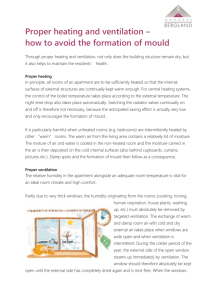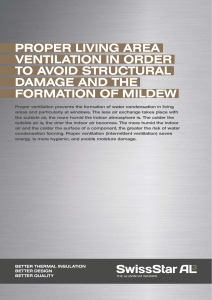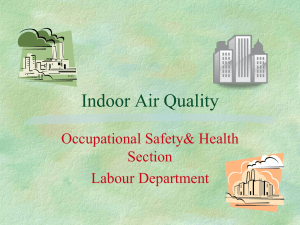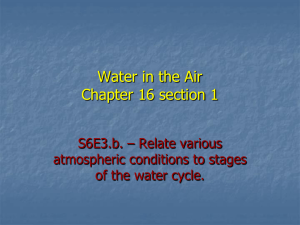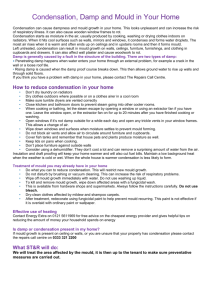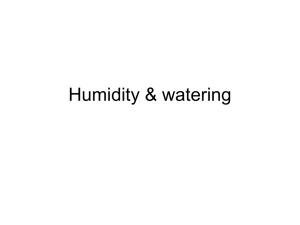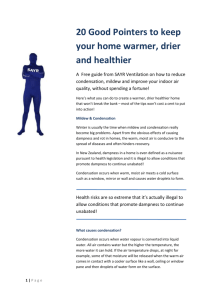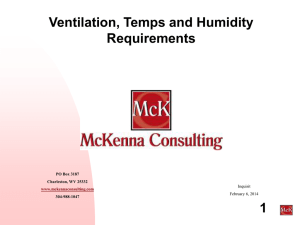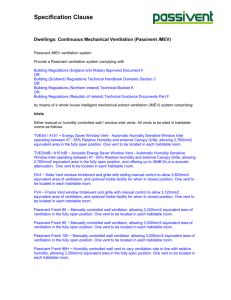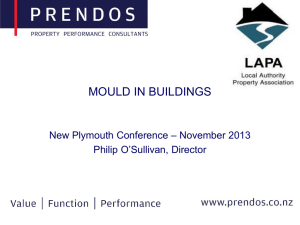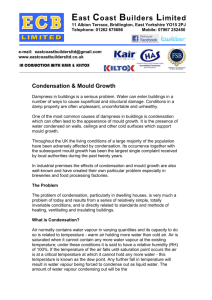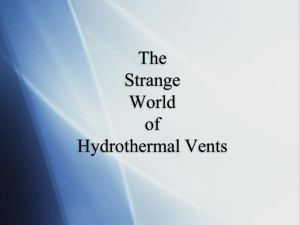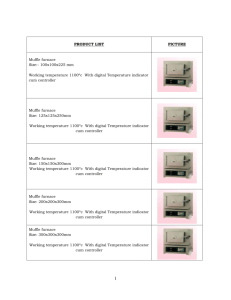Sources of Condensation
advertisement
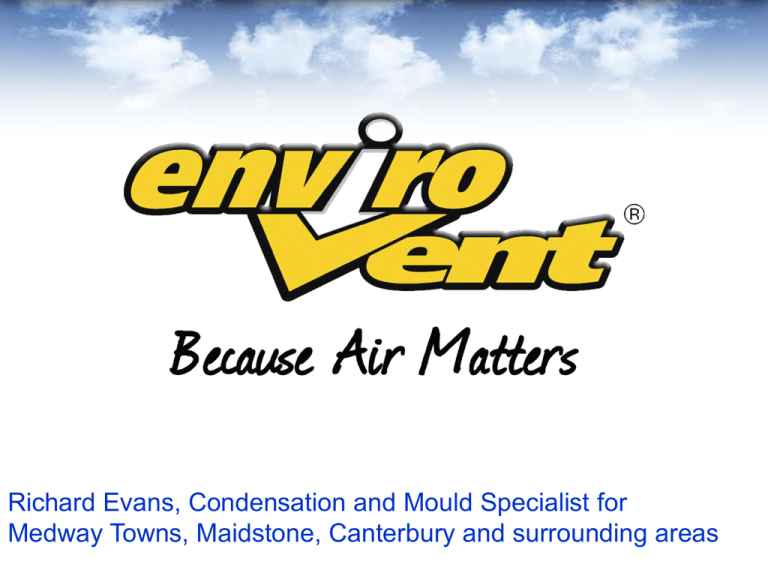
Richard Evans, Condensation and Mould Specialist for Medway Towns, Maidstone, Canterbury and surrounding areas Design Manufacture Survey Install Maintain Agenda Scoping the problem Who is legally responsible? Causes? Possible Solutions Choosing the best solution Plan of action Costs? Questions? How big is the problem? 1 in 5 of all UK properties suffer from Condensation Perhaps 1 in 3 tenanted properties suffer from condensation!? Are we responsible for stopping it? Housing Health and Safety Rating System The requirement is that a dwelling should be free of category 1 hazards. Hazards in Group A are classed category 1. Hazard Group A - Physiological Requirements Damp & Mould Growth Description of the hazard 1.01 This category covers threats to health associated with increased prevalence of house dust mites and mould or fungal growths resulting from dampness and/or high humidity's. It includes threats to mental health and social well-being which may be caused by living in the presence of damp, damp staining and/or mould growth. Why? Health Dust Mites Commonly considered the most common trigger of Asthma Initial exposure can result in long-term asthma There is an asthma sufferer in every five households in the UK Tobacco Smoke and Particulates 5-10% of all lung cancer is linked directly to passive smoking” “Babies and children in smoky atmospheres are twice as likely to have asthma and chest infections as well as coughs, colds and wheezes” What causes it Tenant or Landlord / Property? Sources of Condensation Water Source Litres (per day/activity) Litres/day for an occupancy of 4 Notes Breathing 1.5 6 Washing and drying clothes 1.5 2.5 Showering 1.5 4.5 Bathing 0.75 0 Cooking 1.0 1.5 Washing floors 1.0 1.0 Large House Plants 0.5 0.5 each Seasonal Storage from furnishings and building fabric 0.9 0.9 Estimated as a rate to lose 5% in wight over 4 months Construction (eg rain/water ingress as vapour through wall brickwork/ cellar ) 0.5 0.5 Not measured. Figures are nominal Construction (new build) ? ? Perhaps 3000 litres total. Most comes out in first 2 to 3 years Totals In most established rented property the daily total might typically be 15+ litres 1.5 ltrs/4.5 kg spun laundry Gas cooking creates more than electric Figures are ‘interpreted’ from the pure data within the below publications. To make sense of the variations, some qualitative assumptions have been made about current UK lifestyles. Where there are significant differences in the raw data, effort has been made to retain the general ratios within the data sources; Hiss-reet http://www.hiss-reet.com/constructions-with-reed/thatched-roof/thatched-roof-architecture/thatched-roof-ventilation.html accessed 17.02.11 National Research Council of Canada http://www.nrc-cnrc.gc.ca accessed 17.02.11 American Society of Home Inspectors http://www.homeinspector.org/resources/journals/Moisture-in-homes.pdf accessed 17.02.11 Tenant Related 1.High Occupancy rates 2.Multiple showers 3.‘Blitz’ heating regimes 4.Working from home 5.Cooking types 6.Closed Windows 7.Doors closed 8.Clothes dried on hot radiators 9.Closing/blocking of vents Building Related 1.Poor Ventilation / ductwork 2.Small Rooms 3.Orientation 4.Exposure 5.Glazing 6.Insulation 7.Wall construction 8.Restricted chimneys 9.Furnishings and structural components 10.Heating Method Solutions Fungicidal paint Pros • Easy • Low cost (c.£50 per room + labour) Cons • Air quality (smoke, dust mites, existing spores) • Active ingredient is soluble Insulated wall linings Pros • Reduces heat loss • Good for highly localised problems Cons • Not effective in isolation –simply moves problem Dehumidifier Pros • Easy • Relatively low capital cost (£100-£200 per room) • Good for acute emergencies Cons • • • • Running costs - £10/month/room (400 watts, 8hrs/day) Noise Regular Maintenance (weekly and annual) No effect on air quality (smoke, etc) Passive Ventilation Air Bricks/Window Vents /Trickle Vents Pros • Relatively low ££ if DIY (Passyfier vents c. £80 each+ install) Cons • 4-10 needed per property (MAXIMUM airflow 2l/s) • Still need MV for Kitchen and bathroom(s) • “If you can’t feel a draught, they’re not working” - Airflow Ltd. • Cold bridging Mechanical Ventilation Pros • Only solution to actively address the problem • Long lasting (subject to quality) • Minimal maintenance • Can be outside tenant control • Improves air quality • Minimal ongoing costs Cons • Initial Outlay (typically £600-£1800 / property inc VAT & installation) Extraction - sucking out the moisture (and heat) from the periphery, drawing in lower humidity, ambient air from outside What Extraction for Condensation? Intermittent Light/timer controlled Semi Continuous Humidity controlled (humidistat) I Continuous Trickle Humidity controlled Humidity tracking Continuous Humidity Tracking Maximum Fan Energy Efficiency Winner, Queens Award for Innovation 2009 Our bathroom unit – typically 1W (max 7W) -around £2 per annum Our kitchen unit – typically 2W (max 26W) around £4 per annum) Life expectancy? – min 5 years and still going strong since 2004!! Positive Input Ventilation (blowing in lower humidity air centrally, forcing out the stale air) Positive Input Ventilation Most cost-effective solution for Bedrooms and Living areas. Core benefits of MVHR (Heat Recovery) at a fraction of the cost Actively takes advantage of the leakage of non-CSH properties Positive Input Ventilation Trickles air in diluting, fresh air continuously A single loft unit recovers heat energy and controls a 4 bedroom house (a wall unit controls a 3 bedroom flat) Redistributes otherwise lost heat Creates a fractionally pressurised environment, reducing draughts by c.66% How we assess the best solution(s) On a per property basis: Constructional aspects Tenant behavioural/occupancy aspects Existing Ventilation Performance Layout Internal/external Relative Humidity Levels throughout Air and Wall Temperatures Wall and loft Moisture Contents Costs Preferential Rates 2011 • • • • • Single Room Unit Single Room Heat Recovery Unit Multiple Wet Rooms Unit Loft Mounted House PIV Wall Mounted Flat Unit £249* (TSP £299) £TBC* (TSP £399) £525 (TSP £650) £535 (TSP £799) £615 (TSP £899) – Plus Insulated ductwork and Box profile if needed @ £100/metre *(£15 premium applies if single unit install) All above figures include standard installation charges but exclude VAT Plan of Action 1. Choose and apply your solution 2. Wait a week or so 3. Remove all mould (with fungicidal wash / vacuum brush / dampened cloth) 4. Redecorate if needed 5. Thoroughly clean furnishings (eg Safeclean) Summary Control indoor humidity and you solve much more EnviroVent; Manufacture, survey, install, support Free Survey Effective, sustainable, guaranteed solutions A Powerful Return on Investment For Professional Landlords, private home-owners and over 400 Social Housing Organisations
